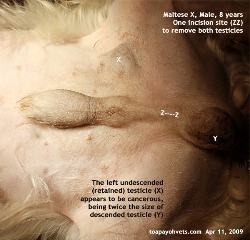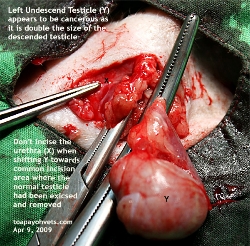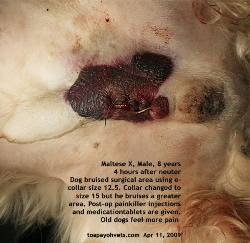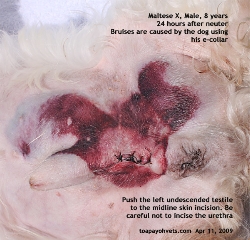Case recorded:
06 April, 2008.
Update:
15 April, 2009
A Veterinary Intern saw her first high anaesthetic risk
case
Dr Sing Kong Yuen, BVMS (Glasgow), MRCVS
The veterinary
intern, a 19-year-old fair and slim Chinese lady with
excellent academic grades at A Levels wrote her
observations. She was present during my case to neuter and
do dental scaling in a Shih Tzu with heart disease and would be working for a new
Veterinary Hospital on April 18, 2009. In 2010, she would
be studying veterinary medicine. All interns at Toa Payoh
Vets are required to write and submit their observations
but some don't do it. Writing their observations
enhance their education and understanding of the actions
in veterinary medicine and surgery. The intern wrote the
following:
 The dog had a
retained testicle which was larger than the normal testicle
which was suspected to be cancerous. The dog had a
retained testicle which was larger than the normal testicle
which was suspected to be cancerous.
However, the doctor
soon discovered that the dogs tongue was turning white
and his heart had stopped beating. Immediately, CPR was
done to resuscitate the dog.
It was not very long before
the dog started breathing again but that period felt
like a thousand years had gone pass.
It was probably due to the age of the dog that his
heart was not able to take the dosage of the anaesthetic.
Luckily, the doctor was able to revive the dog and quickly
got his teeth scaled before he woke up again. After that,
I bathed and groomed the dog. |
My report on the case
 "Listen
to the breathing sounds," I asked Mr Saw to put his ear
close to the opening of the endotracheal tube which had
been disconnected from the anaesthetic machine. Mr Saw
shook his head. He cupped his fingers on the chest. "No
heart beat," he shook his head again. So, was there any
hope? The dog did not respond for the first minute
of resuscitation. No breathing chest movements seen. So
this one minute "really felt like a
thousand years". "Listen
to the breathing sounds," I asked Mr Saw to put his ear
close to the opening of the endotracheal tube which had
been disconnected from the anaesthetic machine. Mr Saw
shook his head. He cupped his fingers on the chest. "No
heart beat," he shook his head again. So, was there any
hope? The dog did not respond for the first minute
of resuscitation. No breathing chest movements seen. So
this one minute "really felt like a
thousand years".
I
stopped neutering. My right hand gripped the chest to
stimulate heart beating while my assistant Mr Saw blew
into the endotracheal tube to inflate the lungs and expel
the anaesthetic gas. He blew once while I massaged the
heart with my right hand firmly 3X and this was repeated
several times over a minute. There seemed to be no hope as this dog
had heart disease and had died since resuscitation took
over 1 minute and no breathing had returned.
 The 8-year-old Shih Tzu took >2 minutes to start
breathing. Chest movements started, indicating breathing
had commenced. The tongue was still pale. No more
anaesthesia was given and the neuter surgery was completed
without the need for more anaesthesia. There was no time
to waste. The 8-year-old Shih Tzu took >2 minutes to start
breathing. Chest movements started, indicating breathing
had commenced. The tongue was still pale. No more
anaesthesia was given and the neuter surgery was completed
without the need for more anaesthesia. There was no time
to waste.
Emergency oxygen could be supplied by pressing
the red valve. However my experience is that blowing via
the endotracheal tube into the lungs and strong cardiac
massage are preferred to revive the dog.
The veterinarian must know what to do in the event of
heart failure during general anaesthesia. In human
medicine, the surgeon just focus on his surgery and
another doctor specialises in anaesthesia. But this is not
the case in
veterinary medicine. A good veterinary assistant with
experience in emergencies would be great but they needed
the hands-on experience. Since such cases are relatively rare
in practice as most dogs are fit for anaesthesia, it is
important that new assistants be given hands-on experience
and mentorship to learn what to do as they become
"paralysed", don't know what to do, when an emergency
heart failure during surgery occurs.
The isoflurane gas was given by mask for a short while to
enable me to do the dental scaling. The dog woke up soon
and had no further problem.
 Post-operation
self-inflicted traumatic injury to the surgical
site happens in some male adult dogs after
neuter despite pain-killers like tolfedine and
rimadryl injections being given after surgery. Post-operation
self-inflicted traumatic injury to the surgical
site happens in some male adult dogs after
neuter despite pain-killers like tolfedine and
rimadryl injections being given after surgery.
The lady owner had said that there was "pus" in the
surgical site and so I had the dog checked at the
6th day. There was no pus. Some blood stains on the
hind paw. The dog was bathed and sent home.
By 6th day after neuter, the redness in the skin had
disappeared 60% due to anti-inflammatory drugs being
given. The dog was normal and active. |
 |
 |
|
 TOA
PAYOH VETS
TOA
PAYOH VETS TOA
PAYOH VETS
TOA
PAYOH VETS